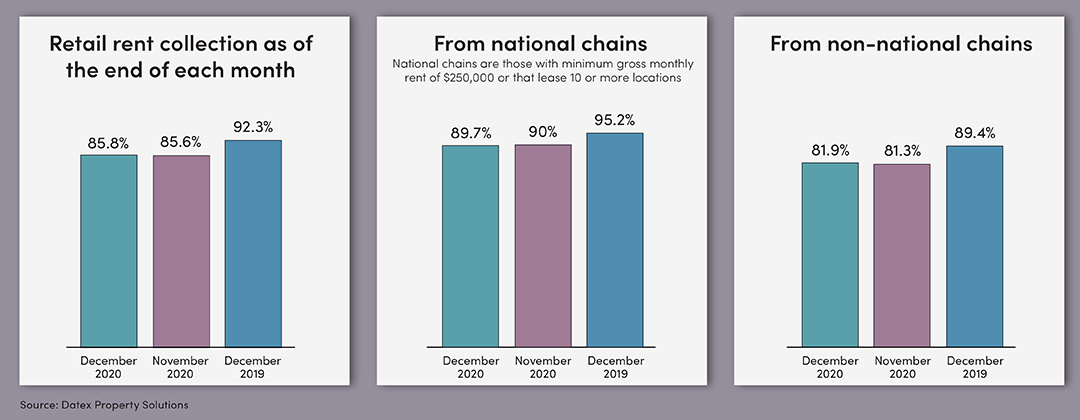Rent collection is returning to a “new normal,” after plunging to unprecedented, pandemic-driven lows during the second quarter, according to Datex Property Solutions’ year-end Tenant Track Report. “Despite the pandemic being an epic destroyer, landlords, tenants and municipalities figured things out for the most part. That is not to minimize the level of fragility everyone feels waiting to cross the chasm from the COVID crash to vaccines at scale,” the report says.
Q1 2020 retail rent collection
In the first quarter of 2020, before the pandemic impacted business, landlords collected about 91.2 percent of total annual rent owed by retailers. They collected 94.5 percent of the rent owed by national tenants and 87.9 percent of rent owed by non-national tenants.
Q2 2020 retail rent collection declined 32.7 percent from Q1
The percentages plunged when lockdowns and government-mandated store closures kicked in for nonessential tenants. During the second quarter, at the low point of the COVID-19 crash, landlords collected about 61.35 percent of total annual rent owed, a 32.7 percent decline from the first quarter. From national tenants, landlords collected 62.35 percent of the rent owed, down by 31.4 percent from the first quarter. And from non-national tenants, landlords collected 60.4 percent of rent owed, down by 31.35 percent.
Q3 2020 retail rent collection rebounded by 32.3 percent from Q2
Landlords and tenants found ways to keep business going despite the hurdles, setting up curbside pickup and delivery services and implementing safety protocols. During the rebound period of the third quarter, the total collection rate climbed by 32.3 percent to 81.9 percent. Landlords collected 84.3 percent of rent owed, up 35.2 percent from the previous quarter. Meanwhile, they collected 78.1 percent of rent owed by non-national tenants, an increase of 29.4 percent.
Q4 2020 retail rent collection climbed again, by 5.7 percent from Q3
In the fourth quarter, landlords collected 85.8 percent of rent owed, up 5.7 percent from the third quarter. They collected 89.8 percent of national-tenant rent owed, up by 6.5 percent from the prior quarter. Meanwhile, landlords collected 78.1 percent of non-national-tenant rent owed, up by 4.8 percent.
Story continues below

Full year 2020 retail rent collection
National tenants showed an advantage over non-national chains. The rent-collection rate for all tenants was 79.9 percent for the full year 2020. For national tenants the collection rate was 82.7 percent, and for non-nationals, it was 77.1 percent.
Movie theaters were the hardest tenant sector from which to collect rent in 2020, according to the report. Landlords collected 43.8 percent of the rent due from movie theaters, 60.7 percent of fitness rent, 69.7 percent of apparel rent, 70.15 percent of hair rent, 74.6 percent of home goods rent, 76 percent of salon rent, 77.5 percent of shoe rent, 78.9 percent of restaurant rent, 82.7 percent of sporting goods rent and 85.8 percent of craft retailer rent. Other sectors like supermarkets and home improvement chains never dropped below 90 percent throughout the tumultuous year.
Merchants can switch from healthy to bankrupt rapidly when cash flow is cut off. 24 Hour Fitness went from a top tenant to one that paid only 39.7 percent of its rent in 2020. The coronavirus severely and adversely impacted categories like theaters and apparel tenants. Others, such as restaurants and salons, took an initial hit but were able to course correct. A fortunate few weathered the storm in good shape; Walgreens, Sprouts Farmers Market and Big Lots were among the chains from which landlords collected at least 99 percent of 2020 rent.
2020 rent collected from specific tenants
Regal: 31.7%
24 Hour Fitness: 39.7%
Cinepolis: 43.6%
Gap Inc.: 45.4%
Victoria’s Secret: 47.2%
Francesca’s: 49.3%
AMC: 54.9%
Lane Bryant: 55.25%
Ann Taylor/Loft: 56.7%
Bath & Body Works: 57.6%
Fantastic Sams: 59.6%
Foot Locker: 60.9%
Chico’s: 61.9%
Old Navy: 63.1%
Supercuts: 63.9%
LA Fitness: 64%
Orangetheory Fitness: 64.7%
GNC: 65.1%
Lululemon: 66.6%
Applebee’s: 67%
Party City: 67.9%
Planet Fitness: 67.9%
Tillys: 69.85%
Barnes & Noble: 69.9%
Red Robin: 69.9%
RELATED: November rent-collection data
By Brannon Boswell
Executive Editor, Commerce + Communities Today